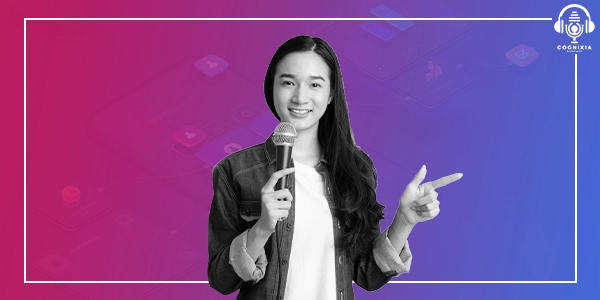Hello everyone and welcome back to the Cognixia podcast!
Every week, we bring you fascinating insights from the world of technology, and today, we’re diving into something you probably use every single day but might not think much about — the dark mode in your apps and devices. Yes, that sleek, eye-friendly interface that turns your bright white screens into a more comfortable dark theme. And trust me, there’s so much more to it than just black and white!
You know how it goes — you’re scrolling through your phone late at night, and suddenly you remember to switch to dark mode. That instant relief your eyes feel? Well, there’s actually some pretty cool science behind that. But before we dive deeper, let’s rewind a bit and understand where this all started.
Remember those old computer terminals from the 70s and 80s? You’ve probably seen them in movies — green text on a black screen? That wasn’t just a style choice. Those early computers used cathode-ray tube (CRT) displays, and it was actually more energy-efficient to illuminate fewer pixels. So, dark backgrounds with light text became the norm. Who would’ve thought that decades later, this would make a comeback as one of the most requested features in modern apps?
Fast forward to today, and you’ll find dark mode everywhere — from your social media apps to your operating system, even your favorite food delivery app probably has it! But what exactly happens when you hit that dark mode switch? Well, it’s not as simple as just inverting colors. Developers must carefully consider contrast ratios, typography, and accessibility guidelines. They need to ensure that text remains readable, icons are visible, and the overall user experience doesn’t suffer.
You might be wondering — is dark mode actually better for your eyes? Well, it’s complicated, but here’s the fascinating part. When you’re using your phone in a dimly lit environment (like most of us do before bed), dark mode can reduce something called visual fatigue. Think about it — when you’re in a dark room, and your screen is blazing white, your pupils are constantly trying to adjust between the bright screen and the dark environment. It’s like walking out of a dark movie theater into bright sunlight — not very comfortable, right?
But here’s where it gets even more interesting — dark mode can actually help save your phone’s battery life! Well, at least if your device has an OLED or AMOLED display. You see, unlike traditional LCD screens, OLED displays can turn off individual pixels completely when displaying black. So, the more black pixels on your screen, the less power your display uses. Pretty neat, right? Some studies suggest you could save anywhere between 15% to 60% of your battery life, depending on your usage patterns. Now that is seriously awesome!

Now, let’s talk about those dreaded blue rays everyone keeps warning us about. Dark mode doesn’t exactly eliminate blue light emission, but it does reduce the overall amount of light coming from your screen. This means less blue light hitting your eyes, especially during those late-night scrolling sessions. And why does this matter? Well, blue light can interfere with your body’s production of melatonin — that’s the hormone that helps you sleep. So, while dark mode isn’t a complete solution to digital eye strain or sleep issues, it can definitely help.
But creating a good dark mode isn’t just about slapping a black background on everything. Developers have to put in some serious work to get it right. They need to consider things like color contrast ratios — the difference between text and background colors needs to be just right. Too little contrast and text becomes hard to read; too much, and can cause eye strain. They also need to think about semantic colors — using different shades of gray and maintaining visual hierarchy in the interface.
And here’s something you might not have thought about — dark mode can actually change how we perceive colors! Our eyes process dark colors differently than light ones, so developers need to adjust their color palettes accordingly. That’s why you might notice that some apps use slightly different shades of their brand colors in dark mode.
The benefits of dark mode go beyond just eye comfort and battery life. For some people with light sensitivity or certain visual impairments, dark mode can make the difference between being able to use an app comfortably or not at all. It’s become an important accessibility feature, helping make technology more inclusive for everyone.
But like everything in tech, dark mode isn’t without its challenges. Some users report that reading long chunks of light text on dark backgrounds can cause what’s called the “halation effect” — where text appears to blur or bleed into the background. That’s why you’ll often see dark modes using dark gray instead of pure black as the background color.
Looking ahead, dark mode is definitely here to stay. We’re seeing more and more innovative implementations, like automatic switching based on ambient light conditions or time of day. Some apps are even experimenting with custom dark modes that maintain brand identity while being easier on the eyes.
So, next time you tap that dark mode toggle, remember — you’re not just changing colors on your screen. You’re engaging with a feature that’s been carefully designed and implemented, considering human physiology, power efficiency, and accessibility needs. It’s amazing how something seemingly simple can have so many layers of complexity and consideration behind it, isn’t it?
Well, that brings us to the end of today’s episode of the Cognixia podcast. We hope you learned something new about this everyday feature we often take for granted. Remember to keep exploring, keep learning, and maybe give your eyes a break by switching to dark mode once in a while!
Until next week, happy learning!

